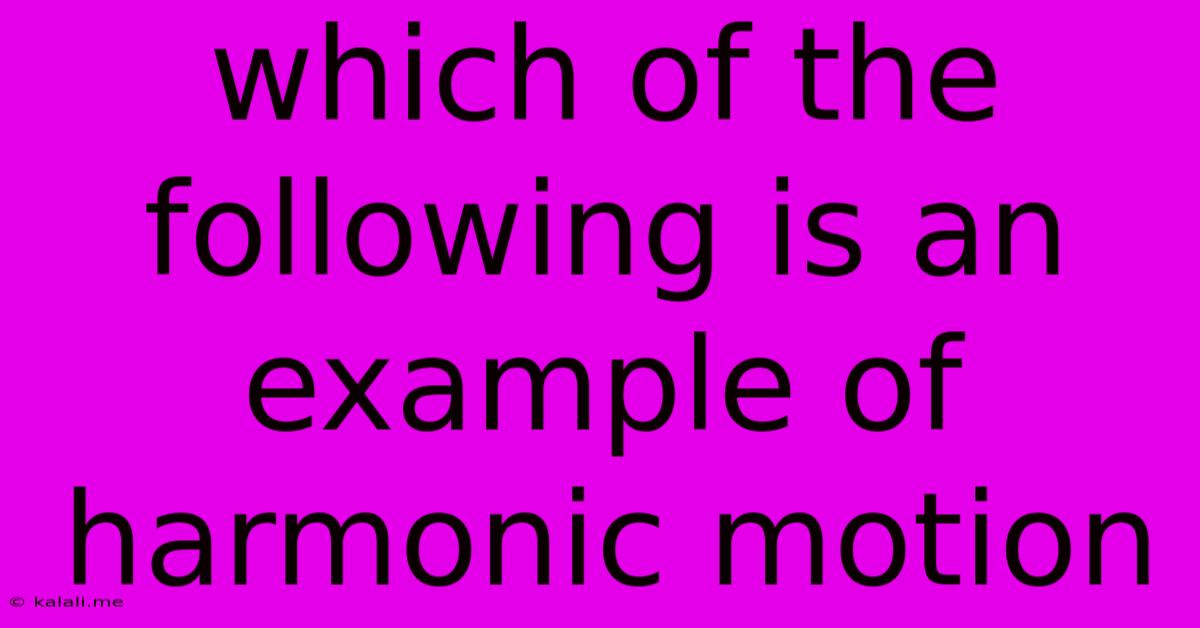Which Of The Following Is An Example Of Harmonic Motion
Kalali
Jun 14, 2025 · 3 min read

Table of Contents
Which of the Following is an Example of Harmonic Motion? Understanding Simple Harmonic Motion (SHM)
This article explores the concept of harmonic motion, specifically simple harmonic motion (SHM), and provides clear examples to help you understand this important physics principle. Understanding harmonic motion is crucial for comprehending various phenomena in physics, from the oscillation of a pendulum to the vibrations of a guitar string. We'll delve into what constitutes SHM and differentiate it from other types of motion.
What is Simple Harmonic Motion?
Simple harmonic motion is a special type of periodic motion where the restoring force is directly proportional to the displacement and acts in the direction opposite to that of displacement. This means the farther an object is displaced from its equilibrium position, the stronger the force pulling it back. This restoring force is what causes the object to oscillate back and forth around its equilibrium point. Key characteristics of SHM include:
- Repetitive motion: The object's movement repeats itself over a fixed time interval (the period).
- Restoring force: A force constantly pulls the object back towards its equilibrium position.
- Proportional force and displacement: The restoring force is directly proportional to the displacement from the equilibrium position.
Examples of Simple Harmonic Motion:
Many everyday phenomena exhibit simple harmonic motion, although they might not seem obvious at first glance. Here are some key examples:
-
A mass on a spring: This classic example perfectly demonstrates SHM. When you pull a mass attached to a spring and release it, the spring's restoring force pulls the mass back towards its equilibrium position. The mass oscillates back and forth, exhibiting a sinusoidal pattern of displacement over time. This is a textbook example often used to introduce the concepts of frequency, amplitude, and period.
-
A simple pendulum (with small angles): A pendulum swinging back and forth with a small amplitude approximates SHM. The restoring force here is the component of gravity acting tangential to the pendulum's arc. While technically not perfect SHM for large angles, the approximation holds well for small oscillations. The period of a simple pendulum depends only on its length and the acceleration due to gravity.
-
A mass bobbing on a liquid: If a mass is suspended from a spring and placed into a liquid, its motion will still approximate SHM. However, the liquid will add damping to the system, decreasing the amplitude of oscillations over time until the system reaches equilibrium. This is a common model in understanding damped oscillations.
-
Vibrating guitar string: When a guitar string is plucked, it vibrates back and forth, creating a sound wave. The vibration of the string, particularly at its fundamental frequency, is a good approximation of SHM. Different harmonics and overtones also exhibit similar oscillatory behavior, albeit at different frequencies.
Examples that are NOT Simple Harmonic Motion:
It's crucial to understand what doesn't qualify as SHM. Here are some examples:
-
A ball bouncing on the ground: While periodic, the bouncing ball doesn't exhibit SHM because the restoring force isn't directly proportional to the displacement. The restoring force is impulsive and depends on the collision with the ground, not a continuous restoring force.
-
A projectile motion: The motion of a projectile under the influence of gravity is parabolic, not sinusoidal. The restoring force (gravity) acts constantly downwards and is not directly proportional to the displacement from the equilibrium position.
-
A rotating fan: The motion is circular and repetitive but not simple harmonic because the direction of the force is constantly changing, not always directed towards the equilibrium position.
Conclusion:
Understanding simple harmonic motion provides a foundational understanding of oscillatory systems. While many real-world systems only approximate SHM, the model remains incredibly useful for describing and predicting their behavior. By recognizing the defining characteristics—a restoring force directly proportional to displacement—you can effectively differentiate between examples and non-examples of this crucial concept.
Latest Posts
Latest Posts
-
Indiana University Of Pennsylvania Gpa Requirements
Jun 14, 2025
-
Second Most Abundant Element In Earth Crust
Jun 14, 2025
-
Which Of The Following Is A Unit Of Energy
Jun 14, 2025
-
The Cpu Consists Of Which Two Parts
Jun 14, 2025
-
What Seismic Waves Are The Most Destructive
Jun 14, 2025
Related Post
Thank you for visiting our website which covers about Which Of The Following Is An Example Of Harmonic Motion . We hope the information provided has been useful to you. Feel free to contact us if you have any questions or need further assistance. See you next time and don't miss to bookmark.